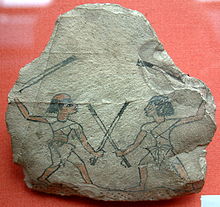Tahtib: Difference between revisions
Grenobulle (talk | contribs) No edit summary |
Grenobulle (talk | contribs) add "Brief Historical Overview" and related references moved from modern tahtib |
||
| Line 33: | Line 33: | ||
==References== |
==References== |
||
{{Commons category|Beni Hassan|Beni Hasan}} |
|||
*[http://books.google.com/books?id=VF0LAAAAIAAJ&source=gbs_navlinks_s Beni Hasan (with plates) by Percy Newberry, et al.] |
|||
*[http://www.archaeowiki.org/Beni_Hasan Beni Hasan - Archaeowiki.org] |
|||
*N. de G. Davies's "Rock Tombs of El Amarna", in openlibrary.org [https://openlibrary.org/books/OL14039904M/The_rock_tombs_of_El_Amarna] |
|||
{{reflist}} |
{{reflist}} |
||
{{Martial arts}} |
{{Martial arts}} |
||
[[Category:Stick fighting]] |
[[Category:Stick fighting]] |
||
[[Category:African martial arts]] |
[[Category:African martial arts]] |
||
Revision as of 12:30, 15 June 2014
This article needs additional citations for verification. (March 2011) |

Tahtib (Egyptian Arabic: تحطيب taḥṭīb) is the Modern Egyptian term for a traditional form of Egyptian folk dance involving a wooden stick, also known as "stick dance" or "cane dance".[1] It is sometimes also described as a "stick-dancing game", or as a highly ritualized mock fight accompanied by music.[2]
A "Nubian" form of tahtib is regularly performed for tourists in Aswan.[3]
Brief Historical Overview

The oldest traces of Tahtib were found on engravings from the archaeological site of Abusir, an extensive necropolis of the Old Kingdom period, located in the south-western suburbs of Cairo. On some of the reliefs of the Pyramid of Sahure (V dynasty, c. 2500 BC);[4] the images and explanatory captions are particularly precise and accurate in their depiction of what seems to be a military training using sticks. Tahtib, with archery and wrestling, was then among the three warfare disciplines taught to soldiers during their training.

More recent in chronological order, yet no less important, three of the 35 tombs of the Beni Hassan necropolis (XI-XII Dynasties, 1900 – 1700 BC) near the town of Minya,[5] display engravings showing scenes of Tahtib. Similar engravings can be seen in the archaeological site of Tell el Amarna (XVIII Dynasty, 1350 BC),[6] some 60 km south of Minya. Finally, the first traces of the festive representation of Tahtib can only be seen in the New Empire (1500 – 1000 BC), as shown by the engravings on the walls of Luxor and Saqqâra [7]
It is believed that during the ensuing centuries, peasants and farmers from Upper Egypt gained gradually access to this art, developing a folkloric and popular version of it. The early Christian writings mention Tahtib as a leisure activity and a popular art, performed by men, during weddings and celebrations.
The stick
The stick itself is about four feet in length and is called an Asa, Asaya or Assaya, or Nabboot. It is often flailed in large figure-8 patterns across the body with such speed and violence that the displacement of air is loudly discernible. There is another form practised from horseback known as “Horse Stepping” which uses a stick that is nearly 12 feet (3.7 m) long.
Performance
Although the dance form originally started as male-only, there are women who perform dressed as men and dance with other women. Another female version of stick dancing has been developed with a flirtatious and generally less aggressive style, and incorporated into cabaret or Raqs sharqi performances. The stick used for this type of dancing is generally more lightweight and hooked at one end like a cane, and generally embellished with metallic-coloured foil or sequins. The costume worn is usually folkloric: a simple Baladi dress, although Ra's el Assaya (Dance of the Stick) is often performed as part of the popularized cabaret dance set. Performance styles include balancing the cane on head, hip or shoulder.
Music
The music used in Tahtib features the tahvol (bass drum) and mizmar (folk oboe). The tahvol is a double-sided drum worn with a shoulder strap so it hangs sideways in front of the drummer and is played with two sticks. The right hand uses a heavier stick with a hooked head to beat out the "dums" which drive the heartbeat of the rhythm, while the left hand uses a light twig as a switch to produce rapid-fire staccato "taks". (Dum = the deep sound from striking the center of the drum with the right hand or with a knobbed stick; Tak = the higher sound from striking the edge of the drum with the left hand or with a light switch).
See also
References
- Beni Hasan (with plates) by Percy Newberry, et al.
- Beni Hasan - Archaeowiki.org
- N. de G. Davies's "Rock Tombs of El Amarna", in openlibrary.org [1]
- ^ Michael B. Bakan, World music: traditions and transformations, McGraw-Hill, 2007, ISBN 978-0-07-241566-7, p. 279.
- ^ Nicolaas H. Biegman, Egypt: moulids, saints, sufis, 1990.
- ^ The Cities Book: A Journey Through the Best Cities in the World, Lonely Planet Publications, 2009, ISBN 978-1-74179-887-6
- ^ T. El Awady, ibid, VI.6.2, p. 208-210 ; D. Farout, Tahtib l’art de l’accomplissement et du bâton, Égypte Afrique & Orient n° 60 (janvier 2011), p. 67-69.
- ^ P.E. Newberry, ' Beni Hassan, Vol. Part 1. London, England: Kegan Paul, Trench, Tubner & Co., Ltd., 1893.
- ^ N. de G. Davies, The rock tombs of El-Amarna, Part II, Pl. 37-38, 1905 (Reprinted 2004), The Egypt Exploration Society,ISBN 0-85698-160-5 http://dlib.nyu.edu/awdl/sites/dl-pa.home.nyu.edu.awdl/files/rocktombsofelama16davi/rocktombsofelama16davi.pdf
- ^ W. Decker, Sports and games of Ancient Egypt, Yale, 1992, p. 83, pl. 52 ; J. A. Wilson, Ceremonial Games of the New Kingdom , JEA 17 (1931), p. 211-220
